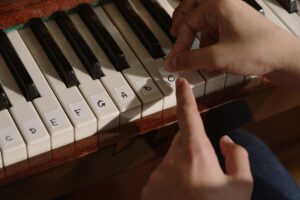The chromatic scale is simultaneously one of the most important and most overlooked scales in music. It is a scale well worth studying for its technical and creative applications. Because the scale does not follow an interval pattern like any of the major or minor scales, the chromatic scale does not contain any of the natural cadence points found in those scales. Instead, the chromatic scale relies on a sort of gestural gravity to make cadences feel appropriate.

What is a chromatic scale?
Chromatic scales are the scales that includes all twelve tones in sequential order:
A, A#/Bb, B, C, C#/Db, D, D#/Eb, E, F, F#/Gb, G, and G#/Ab. Chromatic scales can start from any of the twelve tones, so there are twelve different iterations or inversions of the scale. Here is a great list of popular riffs using the chromatic scale.
Chromatic scale fingerings
Check out this example of the C chromatic scale:

Can you identify any patterns in this fingering? Each time you move from a black key to a white key, use your third finger followed by your first finger. When there are two white keys in a row, use your first finger followed by your second finger. This is a great pattern to practice between chromatic notes.
If you do not feel comfortable with these sorts of piano finger patterns, online piano lessons from Skoove could really help you out!
Practice this fingering slowly and gradually build up speed as you become more comfortable and confident. If you practice slowly, you will soon be able to fly through this finger pattern.
When you feel comfortable with the right hand fingering, begin to practice the left hand finger pattern:

What patterns do you notice in this left hand fingering? Is the left hand finger pattern the same or different from the right hand?
The left hand pattern shares a similar gesture as the right hand between consecutive black and white keys, using the third finger followed by the first finger, but is mirrored on consecutive white keys, using the second finger followed by the first finger.
Again, begin by practicing this left hand fingering slowly and gradually build up speed until you can burn through it.
Once you feel comfortable with right and left hands separately, try to practice the piano chromatic scale with both hands together as shown below:

Chromatic scale variations
Now that you understand the fingering for the chromatic scale with both hands, it is time to introduce some variations into your piano scales practice.
All twelve keys
First, practice the chromatic scale one octave with both hands in all twelve keys. Pay special attention to how and where your fingers move in unison and where they move contrary to one another.
Contrary motion
Next, you can begin to practice the piano chromatic scale in contrary motion. Practicing a scale in contrary motion means that one hand performs the scale ascending while the other performs it descending. It is well worth your time to practice all of your scales in contrary motion if you are not already doing so.
It is easiest to begin practicing the chromatic scale in contrary motion from D because the fingering is symmetrical.
Check out the diagram below for the chromatic scale in contrary motion starting from D:

As with the other examples, practice this chromatic scale in contrary motion slowly until you can race through it. This is a great exercise for building dexterity and speed on the keyboard.
Once you feel comfortable with one octave, you can expand the exercise to two or even three octaves.
Contrary and parallel motion
You can also vary the exercise by alternating contrary and parallel motion. Begin as notated above from D and, once you reach the end of the first octave in contrary motion, ascend both hands together in parallel motion another one octave so that your right hand is two octaves higher than you began and your left hand is in its original position.
There are as many variations on this sort of motion as you can think of. Use your imagination and avoid boxing yourself in with your thoughts! Practicing patterns like these are great for building strong piano technique. Lessons with Skoove can help you to do this easily and efficiently!
Sequence patterns
Have you incorporated any sequence patterns into your practice? Sequence patterns are a fabulous way to increase speed and dexterity on the keyboard. The chromatic scale is especially well suited to these sorts of patterns.
A sequence is essentially a repeating pattern of notes that can be modulated up or down a scale, or the pattern can remain static. First, check out this three note sequence pattern in the piano chromatic scale beginning from middle C:

To construct this pattern, begin with middle C, ascend three tones in the scale, then begin from the second tone, C#, and ascend another three tones in the scale, then begin from the third tone, D, and ascend another three tones. This pattern continues ascending until you reach C one octave higher. You can then descend with the reverse pattern.
Here is the same pattern notated for the left hand:

What similarities do you notice between the right and left hand finger patterns for this three note sequence?
Once you feel comfortable with this pattern with hands separately, try to practice this sequence with both hands as notated below:

Like the previous examples, there are as many variations of this pattern as you can imagine. As soon as you are confident with this sequence with both hands from C, try to modulate the pattern through all twelve key signatures. You could extend the pattern one, two, or three octaves. You could apply the same three note sequence concepts to the contrary motion example from D and also to the mixture of contrary and parallel motion.
Improvisation with the chromatic scale
How often do you incorporate improvisation into your piano practice? Improvisation is a wonderful practice for tuning in to your creativity and musical imagination. The chromatic scale is a perfect vehicle for improvisation as it includes all twelve tones unlike piano blues scale!
For more on improvisation check out this lesson from Skoove:
Play through the following examples of improvised lines inside the chromatic scale:
Example 1:

Example 2:

Example 3:

Use these examples as inspiration for your own improvisations. The chromatic scale is a wide open frontier to explore. The only boundaries are the limits to your own imagination! Since it also includes twelve tones, it does not have scale degrees in the same way the major and minor scales do.
Additionally, if you are feeling daring, you can practice improvising with the chromatic scale using some basic piano chords in your left hand!
Check out the scale generator
Check out this piano scale generator for an interactive approach to piano scales. This scale generator is a helpful tool in learning the major and minor scales. All you need to do is click on the root note on the keyboard and select the major or minor scale.
The software program displays all the notes in that particular scale on the keyboard. This is an advantageous program if you want quick and easy access to all the major and minor scale patterns on the keyboard. Check it out and get creative!
If you are reading this from a mobile device, rotate it to display the tool in full width.
If you are reading this from a mobile device, rotate it to display the tool in full width.
Conclusion
The chromatic scale is an exceptionally useful scale to practice and understand for its applications in the development of strong and fluid piano technique and creativity. If you diligently follow the steps and examples laid down in this article, you will have an excellent command of this unique scale in no time!
If you are interested in topics like the chromatic scale, as well as fun and exciting piano repertoire, simple and straightforward piano technique, and some interesting music theory, then you should check out the 7-day free trial of Skoove! With over 400 lessons, you are sure to find something that piques your interest and makes you a better pianist at the same time!
Author of this blog post:

Eddie Bond is a multi-instrumentalist performer, composer, and music instructor currently based in Seattle, Washington USA. He has performed extensively in the US, Canada, Argentina, and China, released over 40 albums, and has over a decade experience working with music students of all ages and ability levels.















